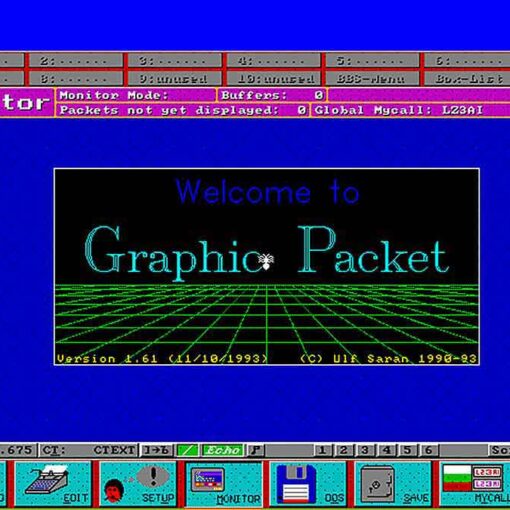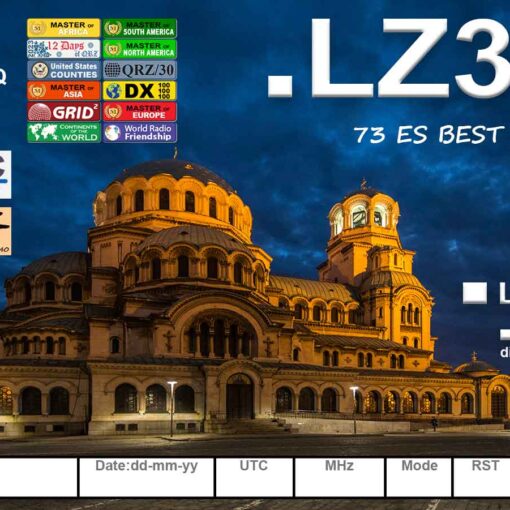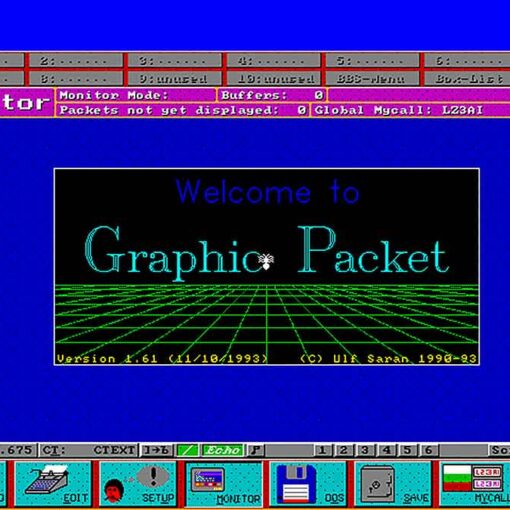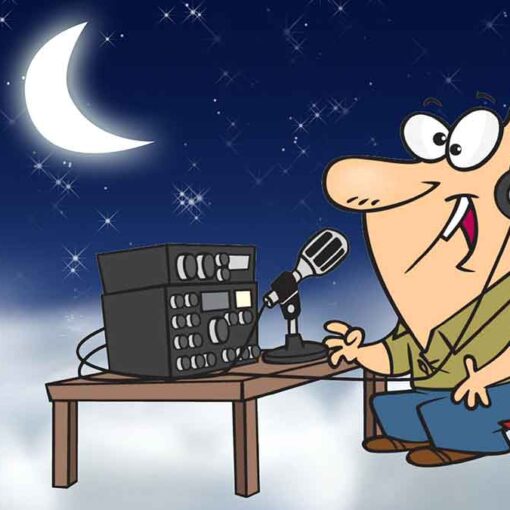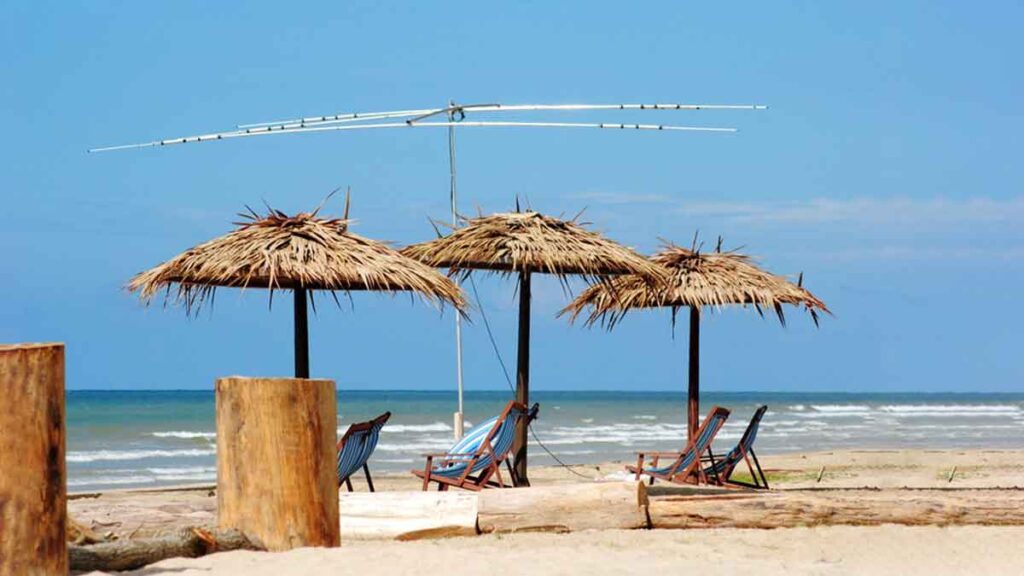
Making a DX QSO is not much different than making regular QSOs. However, there are certain peculiarities due to the increased interest in DX, and sometimes even due to his personal qualities. In any case, however, the ethical rules must be at a high level in order to make the DX correspondent accessible to more radio amateurs. And here the rule of justice applies – do not do to others what you do not want to be done to you.
And we must never forget that we ourselves are DX to our DX correspondents, and that there will always be undisciplined and arrogant colleagues whom we cannot influence except by personal example.
The positive here is that with experience, the more ethical ones prevail over the big (often above the allowable) power and huge antennas.
You step in line
What is he like? He avoids the competition by trying to be faster than his shadow. It listens to the station that is working DX and a split second before that station goes on transmission it fires its initial, very often over the station in question… Figuratively speaking, your turn comes.
And strictly speaking, doing so is even illegal, because you are intentionally transmitting on another station, thus causing it interference. In many cases they not only step on the tail, but more or less show themselves as beasts. This procedure is not at all polite, it is downright aggressive. The consensus is: don’t.
The Endless Screamers
Yes, they exist and there are many, many of them. They just want to make a new, rare correspondent by any means necessary. They don’t give a second thought to the other stations. They only broadcast their initials, just like a radio broadcast station and hardly listen. Sometimes the DX station can be heard answering them, even two or three times, but no response from them. They don’t hear the DX station because they (almost) never listen, maybe because they’re kind of like alligators. Calling a DX station seems to be their hobby, but not working DX.
All this would not be so bad and so sad if they did not cause so much QRM to the other stations with this shameful practice. What they do is pure and simple jamming.
This endless shouting is perfect evidence of selfish behavior, shame on those who practice it.
Using abbreviated call signs
This is a bad habit and undisputed proof of bad practice as an operator, we come back to this issue again.
In most networks, callers are prompted by the master of ceremonies to state only the last two letters of their initial. This is ineffective, and additionally illegal in many countries (you must always identify yourself with the full call sign as received by the administration).
Controllers use as an argument that they don’t want to know the full initials of the calling stations so they can’t announce them on the air and have the DX station pick them up. Noble, but pointless.
The Master of Ceremonies may request that stations be called truthfully, meaning with their full initial. If the DX station accepts the initial at this point, so much the better for it.
If later in the procedure the Master of Ceremonies calls the stations that have applied, then he can call them by the last two letters of the initial, which is perfectly legal. The rules establish how you must identify yourself, but not how to call another station.
Example:
– The host says: “stations for ZK1DX please apply”.
– OH9ZZZ gives his full initial: “OH9ZZZ”.
– Later in the proceedings the presenter calls OH9ZZZ, simply saying “the station with ZZ at the end, call”.
– Now OH9ZZZ calls the DX station: “this is OH9ZZZ, oscar hotel nine zulu zulu zulu calling ZK1DX, 55 for you” etc
It couldn’t be simpler and every step of this procedure is legal.
Some are even starting to use this two-letter procedure outside of DX networks, for example in DX pileups.
But in addition to being illegal, it is ineffective. Why?
– Simple math says: assuming your initial is 6 characters long, if you submit only the last two letters, the probability that at least part of your initial will be accepted is three times less than if you submit all 6 characters
– Your initial is unique; two letters from your initial is far from unique. This means that this procedure often leads to confusion (several stations with the same two letters calling at the same time).
– If the DX station accepts your two letters (fortunately you are the only one whose initial contains those two letters), it has to ask for the rest of the initial. This is a complete waste of time. If the DX ussings to accept two letters, it has a very high probability of accepting all 6 characters. Be aware that this takes time, creates confusion, and increases the likelihood of QRM.
Conclusion: never submit just part of your initial. Are you ashamed of him? Always convey your full initial, be proud of it!
If, under some circumstances, someone asks you to identify yourself with just two letters of your initial, give them the whole thing, and maybe you should add that you don’t do what they ask because it’s illegal.
Miscellaneous Trivia for DX Stations and DX Expedition Operators
Maybe sooner or later you’ll find yourself working on the other side of the paypal. Maybe you’ll be a DX-pedition operator, a dream for many hams. For serious operators, there are a number of guidelines and procedures that must be followed if they are to be successful operators.
Here are some trivia:
Broadcast your initial after every QSO. If your initial is very long (eg SV9/LZ2ZZZ/P), at least transmit it over a few QSOs.
If you’re working simplex and start having trouble getting the initials (because too many stations are calling you on the same frequency at the same time), switch to spread frequencies and spread out the callers. Remember that especially on the low bands, where signals over long distances can be very weak, you will be easily overwhelmed by your calling stations, who will easily be 50 dB louder than you. For a rare DX station, multi-frequency operation is the only way to go.
Before switching to spread operation, listen to make sure the frequencies you want to use for reception are clear.
If you work on spread frequencies, mention this after each QSO. Example for CW: “UR 5, or UP 5/10, or QSX 1820” etc. On SSB: “listening 5 up, listening 5 to 10 up, listening on 14237, 5 up, 12 down” etc.
On spread CW, listen at least 2 kHz up (or down) from the transmit frequency to avoid interference on your signal from your callers’ key clicks. A difference of only 1 kHz, if it is not an exception for a short time, is not enough.
On SSB, the difference should be at least 5, preferably 10 kHz. The signals of some of the calling stations can be very wideband and splash all the way to your transmission frequency.
If, as a DX station, you are operating on scattered frequencies in the DX window on 80m (in Region 1: 3.5 – 3.51 MHz on CW or 3.775 – 3.8 MHz on telephony), listen for the paylap outside the DX window. If you are transmitting on eg 3.795, listen below 3.775 MHz for the paylap (on CW – above 3.51 MHz).
Keep the listening window as narrow as possible to prevent interference to other users of the range.
If you accept only part of the initial on the SSB, reply with that part of the initial plus a report, eg lanky oscar 59”. Don’t say lazy oscar, please again”. Guaranteed to attract a whole flock of Yankee Oscars! If you added report 59, you’ve made half the QSOs, and there will be fewer out-of-order callers.
On CW, in such a case, never transmit a question mark if you have partially accepted the initial (for example, ЗТА). The question mark will ignite half of the pailapa to start yelling at you. Submit “ZTA 599”, not “?ZTA 599”. Never pass a question mark in a paylap situation.
The following rule applies to all classes of broadcast: if you initially accepted the initial in part, transmit it in full as soon as you accept it in full, so that the station calling you will be sure that you have accepted its initial and enter you in the log.
An example. Imagine that at the beginning you partially accepted: “ZTA”. Give “ZTA 599” (say “3TA 59” on the phone). The station confirms “TU DE OH, ONZTA 599” (on telephony: “Oscar hotel, oscar hotel three tango alpha 59 QSL?”). If you now confirm with “QSL TU” (in telephony “QSL, thank you”), there is no way for UNZTA to be convinced that you have made a connection. Therefore, confirm with: “UNZTA TU” (on telephony “UNZTA, thank you”).
Once you answer a partial initial, stick to that station and don’t let it get crushed in power by other callers. You are the frequency boss. You decide who to work with, no one else. The pileup can be very undisciplined, but often this is due to the lack of authority of the DX station operator. If the mob notices that you’ve gone for the opening partial initial and their calls out of order don’t lead to a result, they’ll all eventually give up and show more discipline.
If you surrender to the partial initial and simply choose one of the loud undisciplined shouters, you are acknowledging that the wild shouters rule the frequency. Now you are in trouble. In many cases, the mess is the result of the DX operator not showing authority or not acting by his own rules.
If the initial partial initial later disappears, no pjust pick off any of the loud undisciplined shouters that have been giving you a hard time for the past few minutes. Just call CQ again and listen a few kHz up or down. Never give the impression that you are responding to undisciplined shouters. Show them that undisciplined calling is worthless.
You have responded to a paylap station (eg JA1ZZZ) and logged it. But he keeps calling you, apparently because he didn’t hear you give him a report. Don’t call him “JA1ZZZ I recorded you” (telephone) or “JA1ZZZ QSL” (CW), call him back and report back. He obviously wants to hear that!
Always follow a standard sequence in your lines.
Example (you are ZK1DX):
ZK1DX 5 to 10 up -> you hear ON4XYZ calling you
ON4XYZ 59 -> you give him a report
QSL ZK1DX 5 to 10 up -> confirm, identify yourself and call again.
If you continue to follow this sequence, the paylap will know that when you say “5 to 10 up” you are switching to receiving for new callers. Always keep the same sequence, the same speed, the same rhythm. That way, everyone will know exactly when to call you. It will be like clockwork.
If the paylap remains undisciplined, do not be impressed by it. If the situation does not improve, simply change the broadcast class or move to another band.
Always stay calm, don’t start attacking the pailapa. What you can and should do is clearly show the paylap that you control the frequency and you set the rules. It is important that the power comes from you.
Do not work so two-letter initials. If you hear such stations, tell them you want to hear “full initials only”.
If, when operating on scattered frequencies, many of the calling stations do not receive you well, it is likely that your transmission frequency is suffering from interference. If this continues, on SSB try shifting your frequency by 5 kHz and tell the paylap where to shift, on CW a 0.5 kHz shift is usually sufficient.
On CW, 40 words per minute is usually the maximum speed that can be used with a rapidly increasing paylap. On the low KB ranges (40 – 160 m) it is better to use a lower transmission speed (20 – 30 words per minute depending on the circumstances).
Always keep the paylap up to date with your plans. When you switch to QRT, tell them. When you need a short break, tell them: “QRX 5” (“QRX 5 minutes”, “wait”). If you are moving to another range, inform the crowd.
If you want to keep the paylap calm and more or less disciplined, as well as keep the transmission frequency clean, the most effective way to do this is to keep the callers happy. Let them know what you’re up to. Remember, they all (with one or two exceptions) want to work with you. You are in high demand!
DX operators sometimes work by numbers or by area according to call signs. This means that they will only respond to stations whose initials contain the selected digit. Statistically, the paylap should become 10 times thinner!
Avoid working with numbers as much as possible, it’s not a very good system.
If you still want to use this method, follow these rules:
- Once you start working on numbers, go through all the numbers at least once. If you go QRT in the middle of the sequence or start calling out random numbers, you’ll cause a mess.
- Never forget that when you work by the numbers, 90% of DXers sit back and bite their nails! They keep an eye on you and carefully count how many stations you work with each digit, and you can be sure that some operators will lose control if you don’t get to their digit soon.
- Always start the sequence with the number 0 and work your way up the numbers one at a time. No flashbacks. Keep it simple.
- Don’t go through the numbers in random order: first zeros, then fives, then eights, then ones, etc… This will drive the paylap crazy. If you follow a logical sequence, the paylap will more or less predict when everyone’s turn will come. A random sequence will make them extremely nervous.
- Work a maximum of 10 stations of each digit. Be careful to work approximately the same number of each figure. If you manage to craft 5 stations per minute, it will still take you 20 minutes to close the loop. This means that some stations will have to wait and idle for almost 20 minutes, which is a very long time. Even if the average wait time is 10 minutes, remember that throughput can change significantly in those 10 minutes.
- Always tell the paylap how many stations you are working with each digit and repeat this information each timet when you change the number in the initial.
The digit call method is rarely used on CW.
A better technique is to thin out the pailapa by working by continent or geographic region. This also gives a better chance to remote areas of the world, from where signals are usually weaker and the passage shorter.
In this case, you specify a continent, which means you insist that only stations from that geographic area call you. Example: if you want to work only North American stations, call “CQ North America only” or on CW: “CQ NA”.
Use this technique primarily to reach those parts of the world where traversal is poor or short-lived.
If you use this technique because the pailap is very dense, rotate quickly between continents and regions. A good rule of thumb is to not stay in the same area for more than 15 to a maximum of 30 minutes.
Inform the paylap of your plans, tell them exactly how you will move between areas, and follow that plan. Switch back to normal operation with all regions/continents as soon as the walkthrough allows.
Both of the techniques mentioned above should be avoided as much as possible with one exception – when searching hard to reach areas.
The main problem with these sensitive methods is that the vast majority of hams sit idle and get annoyed. Nervous DXers can easily turn into aggressive “cops”. If you go QRT or change bands just before it’s their expected turn, you’re setting yourself up for a long discussion about your reputation on the frequency you’ve been transmitting on.
We have seen some DX operators try to work country by country. This should be avoided at all times for one obvious reason: you are making 99% of the DXers willing to work with you wait. This modus operandi guarantees chaos at all times.
Be careful when working preferentially with your friends or with stations from your country. Do it very discreetly and only when you are sure you are doing it invisibly. And above all – don’t do it.
So far we’ve presented a set of questions, all related to amateur station operating procedures, all aimed at making DX chasing more enjoyable, both for the chasers and the DXers themselves. It is obvious that through training and practice these two groups can improve their operator skills and achieve a win-win situation for both, and thus a better DX world.
At some point, sooner or later, almost all of us have encountered a situation where intentional jammers have spoiled the enjoyment of thousands of DX chasers. They QRM the DX frequency either without transmitting a call sign or using a call sign that they “borrow” for their unethical behavior. This question is really a question of ethics, a question of good or evil and is not a matter of procedure in ham radio practice.To a large extent this kind of QRM will not be changed by training or practice.
These deliberate QRMs (DQRMs) are caused by a small group of public hooligans with no basic moral standard. Their actions are simply a manifestation of an ever-increasing degree of selfishness that, unfortunately, we have recently found in many layers of society.
If you suffer from similar DQRM, shift slightly, say 500 Hz on CW, transmitting your initial, followed by a series of DIs that you slowly shift so the paylap knows what you’re doing, or on telephony, say 5 kHz up, or down by announcing the offset in advance. Do not report a reason for the latter.
Never advertise that DQRM is hurting you. These few individuals challenging DQRM will most often cease to act if they do not have an audience, in other words, to respond to their provocations. Always ignore those, but never retreat.
